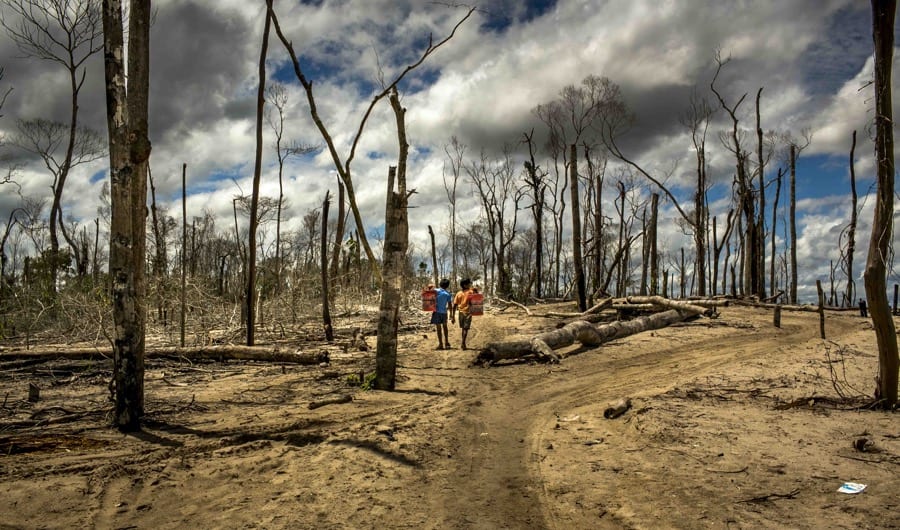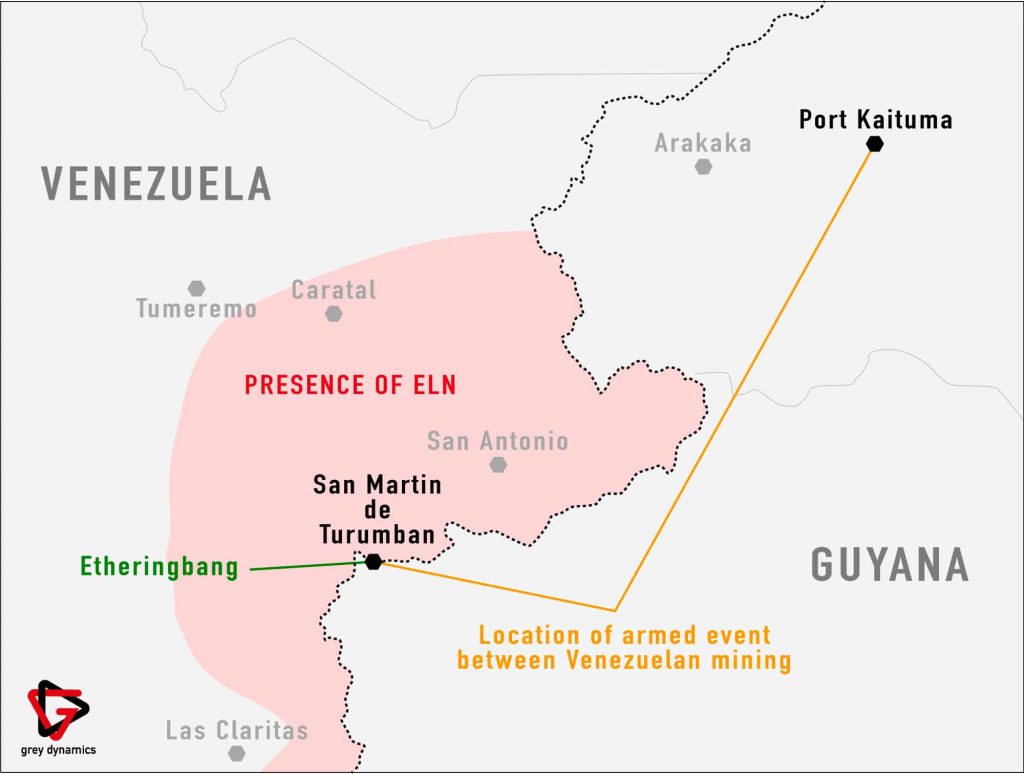
Illicit Mercury Market: A Background
Illicit mercury markets are a current big threat. The Minamata Convention, established in 2013, is a global effort to decrease the use of mercury in mining. Countries like Guyana ratified the agreement, dropping mercury imports from 80 to 5 tonnes a year. Nevertheless, mercury is crucial to illicit mining in Southern Venezuela and Guyana. The illicit mercury market continues to grow, as do its consequences.
Assessments & Potential Threats
- Asignificant increase in the supply of mercury to Venezuela might realistically threaten foreign oil investments in Guyana. Current mercury from Guyana is not profitable to most armed actors in Venezuela. An increase in potential profits risks the proliferation of criminal actors and increase of security threats.
- The border between Venezuela and Guyana is almost certainly officially non-existent. Legal disputes and trade opportunities make the Cuyuní river a transport route rather than a national border. The presence of criminal activity in Venezuela is unlikely to halt an expansion and limit activity by national borders.
- It is unlikely that the arrival of mercury to Guyana will decrease significantly in the following 12 months. Corruption and under-reporting deny any capability to deter or monitor the proliferation of the use of mercury. The lack of control creates an environment ideal for environmental and health pollution due to an un-regulated use of mercury.
Background
The Minamata Convention and issues with mercury:
- Minamata, a Japanese city, suffered long-term mercury poisoning after an industrial accident.
- Mercury is used in gold mining as a method to accelerate the process and increase efficiency.
- Whether inhaled or by touch, mercury is corrosive to skin, eyes and can lead to lung and organ failure.
- Mercury pollutes the environment, poisoning natural resources used by communities and reducing the presence of wildlife.
- The convention seeks to reduce the general use of mercury, risks of accidents, and biological damage.
Guyana adopts the profile of a distributor of illicit trafficking, in particular minerals and narcotics. The capital, Georgetown, reportedly serves as a distribution point for organised crime to export narcotics. Substances like cocaine use Guyana as a passage. Instead, the illicit mercury market and unregulated gold mining are adopted as a primary illegal economy. In 2020, illicit gold mining decreased by 7.8%, while there was an increase in small and medium-scale miners of 8.3%.
Venezuela currently remains a minor trafficking destination compared to Suriname and Brazil. The IUCN claims that Corriverton, in the Suriname-Guyana frontier, is the only main trading hub apart from Georgetown. Smuggling is extensive in the Suriname frontier. Nonetheless. the presence of armed actors in the Venezuelan frontier makes the latter highly likely more volatile. An illicit mercury market already informally developed, with a risk of organised crime dedicating serious capabilities to its exportation.
Instability, Oil & Foreign Investments in Guyana
Oil Exploration
ExxonMobil discovered in 2015 large amounts of offshore oil reserves. This amounted to an estimated equivalent of 8 billion barrels and potential of 800,000 barrels a day. With production beginning in 2019, profits sit at $246 million with ExxonMobil importing 5 million barrels of oil. Due to oil production in 2019, the World Bank predicts growth of 43.48% of Guyana’s GDP in 2020. These predictions are taking the COVID-19 pandemic into account too. The illicit mercury market initially has no relation to foreign investments. Guayana might fail to generate a perception that they distribute profits from oil deposits amongst the population. This will likely increase sentiments against the presence of PFOs (ExxonMobil). This might also increase participation in illicit economies. The profitability of the illicit mercury market likely drives part of the operational stability of foreign investments.
Domestic Unrest
Ethnic divisions characterise the socio-political status of the country, as a majority of the population divided between Afro-Guyanese and Indo-Guyanese ethnicities make up the 790,376 citizens. Elections in March 2020 between the ‘People’s Progressive Party’ (PPP) and the ‘A Partnership for National Unity’ (APNU) resulted in victory for the PPP, with contested results extending the election decision until July. Protests and result-rejection caused 3 killings with almost certain ethnic motivations. With 36.3% of Guyanese living below the poverty line and one-third of the population (Indo-Guyanese majority) concentrated in the capital, it is likely that alienated communities engage in alternative profit means like the illicit mercury market.
Mercury as an Asset
Transport
The negative press of mercury and ratifying the Minamata convention make it likely that the majority of mercury enters Guyana through illegal means. Infoamazonia established that contrabandists obtain legal imports, including from the US, are through bribes towards officials in Georgetown. Meanwhile, Chinese importers smuggle illegal mercury with the alleged support of the Chinese embassy. While the veracity of official Chinese cooperation is uncertain, it is almost certain that there is an illicit mercury market in Georgetown.
The easier transport and smuggling becomes, the higher the likelihood of armed actors proliferating in Guyana. Geographic difficulties and COVID-19 reduced the flow of mercury towards the Cuyuní river dividing the Venezuelan-Guyana border. Via air or maritime transport, transporting mercury past the Venezuelan border generates a series of ‘alcabalas’, or informal checkpoints by governmental or non-state actors demanding a share of the potential profits. The illicit mercury market, evolving from its secondary role in illicit gold mining, is likely to increase its role in the Cuyuní border as material becomes easier to obtain.
Cost & Quality
The illicit mercury market is likely driven by the purity of mercury as well as the cost of transport and manufacture. The purity of mercury determines its health risk and its effectiveness in gold mining. Actors like the ELN, mining criminal syndicates (sindicatos), or small-scale farmers take part in illegal gold mining using mercury, described by local miners as essential as it attracts gold. The difference in capabilities between actors, as well as state corruption, likely make the availability of pure mercury reduced in the state of Bolívar compared to Guyana.
The cost of the illicit mercury market is highly likely dependent on an individual’s subjective trafficking and transporting conditions. Alcabalas significantly increase the cost of transporting mercury through the Cuyuní river and out of San Martin de Turumbán, both from state actors like the Bolivarian National Guard (GNB) or non-state actors like the ELN. While Mercury in Etheringbang is sold between 8-14 grams of gold per kilogram of mercury, in Ciudad Guayana miners are charged 25 grams per kilogram of impure mercury. The cost of transport, bribes, and payments of Guyanese mercury exceeds the cost of Venezuela-originated ‘quicksilver’, despite original prices suggesting more profits are obtained from Guyana.

Armed Actors & Intervention Potential
Groups with sufficient capabilities like the ELN have the opportunity to establish the illicit mercury market with a flow of mercury from Guyana. According to ACLED’s data recollection, 3 armed events took place from June 2020 to June 2021, involving non-state actors out of which 2 events involved Venezuelan actors. In September, sindicatos opened fire on a jeweler in Port Kaituma and in January, on gold miners on the Guyanese side of the Cuyuní river. Miners on Guyanese soil are targeted and the potential of Guyanese mercury provides increased profits, demonstrating the capability of criminal actors to significantly blur the border between countries. Groups like the ELN with higher capabilities than sindicatos are likely to divert resources and attempt to establish a flow of mercury or exploit the profit potential due to a higher purity.
An increased presence of armed actors is a direct risk to foreign investment, despite ExxonMobil’s presence being offshore. The Essequibo, the eastern region of Guyana is under dispute with Venezuela due to historical disagreements on treaties and colonies. The region has a potential for at least $44 billion of profits from oil barrels, making it crucial for both nations. Although the dispute is currently referred to the ICJ, Maduro rejects the resolution. In January 2021 expressed his desire for the UN secretary-general to resolve the dispute. An increase in the presence of armed actors originating in Venezuela, whether for trafficking or mining extortion, would likely polarise the discussion and place ExxonMobil as a foreign U.S. threat to Venezuela.
Intelligence Cutoff Date: 30th of June /2021 (UTC -7)

